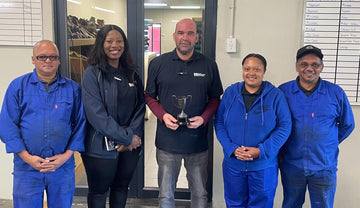
Leather gracefully glides alongside the exclusive luxury company in the vast panorama of materials. Glossy pages habitually showcase extravagant handbags with breathtaking price tags, perpetuating the notion that leather is a material fit only for the creme de la creme. But, as we venture beyond this whimsical facade, the truth unfolds. Far from a mere symbol of opulence, leather is a practical, durable, and economically sensible choice for everyday essentials like seats, bags, and shoes.
Leather: A Sage Investment for Red Wing and Irish Rail
Enter the world of Red Wing, the venerable 120-year-old artisan of work boots. Their latest collection, baptised "Same Old," unveils a tapestry of over 40 upcycled boots and Red-Wing branded relics spanning the ages. Launched via a whimsically dedicated website in 2021, this limited-edition collection encapsulates an ethos rooted in longevity, durability, and the art of enduring style. As Jamie Kvamme, Red Wing's marketing director, says, "Our products inherently last for a long time, and they last with care."
These refurbished artefacts, from WWII-era Skytroopers at $800 to the $180 Weekender Chelseas, tell a tale of affordability interwoven with the enduring charm of craftsmanship. Red Wing breathes new life into forgotten pieces through this initiative, sparing them from a mundane fate in landfills. The very essence of the "Same Old" campaign rests in the leather component, where durability and longevity metamorphose into a tangible second lease on life.
In a parallel narrative, Irish Rail unfolds its strategic choice of leather seats, echoing the practicality and value for money that leather so eloquently offers. Over 12 years, fabric seats would commandeer a staggering $6.2 million, including cleaning costs. In its sumptuous grandeur, Leather stands at $2.8 million, resulting in a colossal saving of $3.4 million and opting for Muirhead leather over its fabric counterpart, Irish Rail champions sustainable durability, comfort, hygiene, and a market-leading warranty, coupled with a $3.4 million windfall in cost savings for seat upgrades.
While the initial investment in leather may seem thrice as extravagant, the saga of leather seats unfolds as a cost-effective investment in the long run. Unlike non-leather counterparts that demand frequent maintenance or annual material changes, leather seats endure gracefully for a remarkable nine years without such interventions. The higher upfront cost of leather pales in comparison to the cumulative expenses associated with maintaining and replacing non-leather seats. It's a surprisingly economical choice that echoes the very essence of practical luxury.

The Leather Industry's Misconstrued Affiliation with Opulence
As the spotlight shifts to the leather industry, an introspective journey unveils a misplaced association with opulence. The industry must acknowledge the disconnect between the $50,000 handbag imagery dominating public perception and the more practical, accessible leather applications. Beyond the sheen of extravagance lies a material not just for high-end fashion but a companion for everyday life – resilient enough for the dance floor antics at your cousin's wedding or the demands of your daily hustle.
The misconception that leather is reserved solely for the affluent stratum inhibits its potential reach. To harness the power of leather, the industry must focus from the minority splurging on extravagant items to the majority seeking everyday products. The $50 pair of shoes or the $75 handbag possesses the latent power to resonate with millions of consumers, making a more significant impact on the industry.
A Call for Targeted Communication and Real Publicity Campaigns
The industry must embark on a quest for targeted communication strategies to bridge the chasm between leather and the discerning average consumer. Emphasis should transcend the allure of luxury, converging on the practical benefits of leather – its healthiness, sustainability, and unwavering reliability. Far from a mere fashion statement, Leather emerges as a sensible and enduring choice for the quotidian.
I urge the leather industry to invest in publicity campaigns that resonate with the everyday consumer. Imagine a world where the $50 shoes hold the key to transformative change, where the benefits of leather reach the masses in a language that resonates. It's time to redirect marketing efforts towards the practicality and affordability of leather, engaging the average consumer in a language uniquely their own.

Leather's Symphony of Style, Durability, and Affordability
In conclusion, leather isn't a luxury reserved for the elite; it's an accessible and economically sensible choice for the rhythm of everyday life. The leather industry must alter its narrative, spotlighting the practical advantages of leather to connect with a broader consumer base. By doing so, leather can establish itself as the symphony of style, durability, and affordability – a perfect blend for those seeking an enduring companion.
Envision every brand, retailer, and consumer to embrace this paradigm shift. As fast fashion's carbon footprint looms, the leather industry, brands, retailers, malls, airlines, and shipping lines could collectively champion the notion that less is more. A world with more disposable income, less waste, and enlightened consumers – a movie-making vision grounded in the tactile reality of leather's enduring allure.




